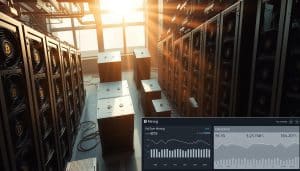With nearly 915 million swaps and more than $1 trillion traded in 2025, Uniswap stands tall in decentralized finance. I was amazed by the volume when I first tried trading ERC-20 pairs. Now, after many trades on platforms like Ethereum, Arbitrum, and Optimism, I understand the trust pros and DIY traders have in Uniswap.
This guide will show you how to swap crypto on Uniswap, just like I do. We will go through each step, highlight beginner mistakes, and share tips to save on gas and time. Our focus will be on swapping tokens on Uniswap, especially ERC20 tokens across Layer 1 and Layer 2 networks.
The guide will also cover liquidity, UNI token features, strategies for gas, and how Layer 2 networks like Arbitrum impact costs. I’ve included a safety checklist and the tools I use while trading. So, this guide is not just theoretical. It’s based on real experiences and data, designed to boost your trading confidence.
Key Takeaways
- Uniswap is a leading DEX with massive swap volume—real use and real liquidity.
- This guide shows how to swap crypto with Uniswap, focusing on ERC-20 token swaps.
- You’ll get a clear step-by-step walkthrough plus safety checks to avoid common mistakes.
- Expect practical tips for Uniswap token swapping on Ethereum and Layer 2s like Arbitrum.
- Later sections cover liquidity, fees, and data-driven context to inform your trades.
What is Uniswap and How Does it Work?
Uniswap pulled me into decentralized finance by making token swaps easy and trustless. It’s basically an automated market maker that sets prices for ERC-20 pairs with a special formula, x * y = k. This means it uses liquidity pools on the blockchain instead of an order book to match buyers and sellers.
This approach changes market-making from big institutions to anyone who adds assets. Liquidity providers put in token pairs and get LP tokens, showing their part of the pool. The pool balances change with each trade, and math keeps the prices moving with supply.
Overview of Decentralized Exchanges
Decentralized exchanges come in two types: order books and AMMs. Order books work like traditional exchanges, matching buy and sell orders. AMMs, like Uniswap, use smart contracts instead. Uniswap’s AMM finds prices on-chain, adjusting pools instead of matching users directly.
This system lets anyone list tokens and add liquidity, making new ERC-20 tokens easier to access. Plus, other DeFi protocols can use Uniswap’s pools for their own needs.
Key Features of Uniswap
Uniswap is known for easy token listing, finding prices on-chain, and working seamlessly with wallets and other DeFi tools. It now works faster and cheaper on Arbitrum and Optimism, thanks to Layer 2 scaling.
LP tokens are a neat way to track ownership and collect fees. Uniswap’s multi-chain support and smart routing let traders find the best deals, saving on costs.
Benefits of Using Uniswap for Swapping Crypto
Swapping on Uniswap offers freedom and a wide choice of tokens. Trades happen on-chain, free from control, letting new tokens appear quickly. Wallet integration makes everything smoother, especially with recent improvements.
Its routing system often finds less expensive trading paths. This saves money when you’re swapping tokens. Plus, Layer 2 and account updates make trading cheaper, even for small amounts.
By 2025, Uniswap had handled about 915 million swaps and crossed $1 trillion in yearly trading. This makes it a key part of the crypto exchange world. Yet, the UNI token’s price hasn’t kept up with Uniswap’s success, showing the difference between how useful Uniswap is and how the market values its token.
Getting Started with Uniswap
I will show you the basics of starting with Uniswap. This guide mixes tips and steps for an easy follow-along. It makes learning crypto swapping straightforward.
Setting Up Your Wallet
For swaps and testing, MetaMask is my top pick. It’s easy to use, widely supported, and connects with WalletConnect and Coinbase Wallet for use on the go. Recent updates make it user-friendly for beginners, but remember to protect your seed phrase and use social recovery if you can.
Download the app or extension, set up a new account, and write your recovery phrase on paper. Add a small amount of ETH for gas, or the layer’s native token you’re using. Always store the backup safely offline.
Choosing the Right Tokens to Swap
To start, verify the token’s contract on Etherscan for safety. Then, check its market data on CoinGecko or CoinMarketCap to understand liquidity and volume. Avoid low-volume pools to prevent poor exchange rates and high slippage.
Try to swap tokens with audited contracts if possible. Choose Layer 2-native tokens on L2s to cut down on bridge fees. This can significantly lower costs even for small transactions.
Connecting Your Wallet to Uniswap
First, select your network. If using Arbitrum, Optimism, or a zk rollup, switch your wallet’s network first. Then, visit app.uniswap.org, click on Connect Wallet, and choose MetaMask, WalletConnect, or Coinbase Wallet.
Connecting is easy: pick your network, connect your wallet, allow token spending, and then trade. However, keep in mind that mainnet transactions can be pricey. Layer 2s and future updates in 2024–2025 will lower these costs significantly.
Remember to consider risks like sequencer centralization and bridge security on rollups. While fees may be low, trading still carries risks. Always weigh cost benefits against these risks when moving large sums.
How to Swap Crypto on Uniswap: Step-by-Step Guide
I’ll guide you through a real swap I made on Uniswap. You’ll learn how to swap crypto from choosing tokens to watching your transaction confirm.
Start by picking a pair of tokens and how much you want to trade. Uniswap finds the best rates across different pools. Check the effect on price and how much slippage to expect before you proceed.
Executing Your First Swap Transaction
If it’s your first time swapping a certain token, you’ll need to approve it. This is a two-step permission process you complete in your wallet. Then, place your swap on Uniswap and sign off on it using MetaMask, WalletConnect, or Coinbase Wallet.
Don’t skip previewing the swap route. It’s good to know the execution price beforehand. With tokens hard to sell, increase your margin for price changes a bit. For well-known pairs, aim to keep this margin tight, about 0.5–1%, to avoid unexpected losses.
Confirming and Checking Your Transaction Status
After sending off your swap, track it using Etherscan or another layer 2 (L2) explorer like Arbiscan or Optimistic Etherscan. These sites show your transaction’s progress, gas fees, and current state.
Different types of rollups handle things in their ways. For example, it might take about a week for Optimistic rollups to send funds back to the main network. ZK rollups usually work quicker.
Understanding Gas Fees on Uniswap
Before confirming your swap, Uniswap shows the estimated gas fee. Fees change depending on the network and how busy it is. Layer 2 rollups can lower these costs by handling many transactions together.
You can adjust your gas settings to either hurry a slow transaction or to save money when it’s quiet. Always be ready for fees to jump suddenly. I set a careful deadline and double-check the fees before confirming.
I follow a few simple tips from my experiences. Keep slippage tight, preview the swap details well, and only approve when you must. These steps help make trading with Uniswap smooth and worry-free.
| Step | Action | Why It Matters |
|---|---|---|
| 1 | Select token pair and enter amount | Sets the trade context and shows price impact for Uniswap token swapping |
| 2 | Review route, price impact, and slippage | Prevents unexpected losses on volatile or low-liquidity pairs |
| 3 | Approve ERC-20 if required | Grants Uniswap permission to move tokens from your wallet |
| 4 | Submit swap and confirm in wallet | Broadcasts the transaction to the blockchain |
| 5 | Monitor on Etherscan or L2 explorer | Verifies confirmations, gas used, and final receipt |
| 6 | Adjust gas settings if needed | Speeds confirmation or reduces cost during low demand |
Advanced Features of Uniswap
I’ve been deeply involved with Uniswap for months. I’ve added liquidity, tried different strategies, and kept an eye on the stats. Uniswap provides advanced tools. These help seasoned users increase their gains and handle risks in liquidity pools and decentralized finance settings on Uniswap.
Here, I’ll guide you through adding liquidity, increasing yield, and dealing with impermanent loss. I’ll use short paragraphs, provide clear steps, and discuss real trade-offs.
Adding liquidity to pools
First, pick a balanced pair of tokens and get your wallet to approve each. When you’re at the pool’s interface, you’ll put in the same value for both tokens and confirm the transaction. You’ll get LP tokens as a receipt of your share. Trading fees go to LPs and help grow your position over time.
Uniswap v3 introduces concentrated liquidity. This lets you set a price range to make your capital more effective around the most traded prices. It’s a way to make your money work harder. But, you need to watch it. Especially if market prices move out of your chosen range.
Yield farming opportunities
Certain protocols offer extra rewards on top of what LPs earn. You can find extra tokens for staking your LP tokens through other farms or rewards programs. I’ve switched between direct LPing on Uniswap and staking in outside farms to grab these extra tokens.
It’s important to remember impermanent loss and transaction fees when figuring out your earnings. By 2025, safer DeFi products have become more common at financial institutions. This change impacts how rewarding outside incentives can be. Think about this when looking for yield farming opportunities.
Understanding impermanent loss
Impermanent loss happens when the price ratio of tokens in a pool changes. Imagine if token A’s value doubles compared to token B. Your stake in the pool might end up worth less than if you held the tokens separately. Often, LPs may earn less than if they simply held their tokens, especially after big price changes.
There are ways to lessen impermanent loss. Try using pools with two stablecoins on platforms like Curve to reduce price changes. Or, use narrow price ranges on Uniswap v3 but check them often. Look for fee earnings and other programs that can make up for impermanent loss over time.
Uniswap’s high trade volume and fees mean LPs can earn well. But, the way UNI’s protocol economics work has not always benefited token holders, leading to questions on governance and profit distribution. These issues are discussed in market reports. Keeping up with these changes is key to using Uniswap for long-term financial strategies.
Analyzing Uniswap’s Market Data
I look at on-chain numbers because they show more than news stories do. Uniswap’s cryptocurrency exchange activity reveals trends in user actions, fees, and token movement. I use charts and tables to understand these changes.
Let’s look at the data in three ways: past volume, current trends, and future token forecasts. This approach is useful for trading, researching, or designing products with Uniswap’s data.
Historical Trading Volume Statistics
In 2025, Uniswap hit a big goal with about 915 million swaps and $1 trillion in yearly volume. The third quarter of 2025 saw a record $270 billion in volume before the quarter ended. These numbers show Uniswap’s steady place in the market and why researchers pay attention to this DEX.
I suggest making a chart to show the 2025-2025 volume and swap count. Include a clear spike in 2025. This makes the gains more obvious than just price charts.
Current Market Trends and Insights
The growth of Layer-2 is causing big changes. Moving activity to Arbitrum, Optimism, and zk rollups has made swaps cheaper and allowed more people to join in. This has increased Uniswap’s token swapping on Layer-2.
There’s more demand for safer DeFi applications like payments, savings, and settlements. This need for reliable liquidity helps Uniswap’s exchange. It allows for better prices and more trading.
Price Predictions for Uniswap Tokens
In 2025, UNI’s price went down, even though Uniswap was doing well. Uniswap Labs made about $50 million, but the total fees were around $1.65 billion. Yet, UNI’s price stayed low, around $8.09.
Experts think that changes in governance could help align UNI’s value with how well the platform is doing. They suggest buybacks, new fee plans, or changes in supply. The use of Layer-2 and new institutional products should keep volume growing.
The future value of UNI will depend on governance decisions like fee changes and buyback programs. Plotting different outcomes can help with decision-making. Consider one curve for active fee distribution and another for no changes in governance.
| Metric | 2025 | 2024 | 2025 (YTD) |
|---|---|---|---|
| Swap Count (approx) | 420M | 680M | 915M |
| Annual Trading Volume | $320B | $760B | $1T |
| Q3 2025 Quarterly Volume | – | – | $270B |
| Protocol Trading Fees (cumulative) | $420M | $1.15B | $1.65B |
| Uniswap Labs Reported Revenue | $12M | $28M | $50M |
| Reported UNI Price (example) | $14.20 | $10.35 | $8.09 |
When advising traders or teams, I highlight the importance of three things. Watching Layer-2 liquidity, governance updates, and new institutional products. These factors greatly influence Uniswap’s token swapping trends.
Tools to Enhance Your Uniswap Experience
I always open a small toolkit before making any swaps. This saves time and helps avoid surprises. Here, I’ll share the tools I use, why they’re useful, and how you can use them in your daily trading and liquidity management.
Recommended Wallets
I mainly use MetaMask for its broad compatibility with Uniswap and other DeFi apps. For people new to this, I recommend the Coinbase Wallet. It’s easy to start with. For trading on mobile or when I need extra security, I connect Ledger and Trezor to Uniswap through WalletConnect.
For big trades, I trust hardware wallets. Ledger and Trezor keep your keys safe offline. They still let you confirm transactions on the Uniswap website. This strikes a good balance between being easy to use and keeping things secure.
Analyzing Swaps with Third-Party Tools
I never just depend on one source to evaluate a swap. I look at on-chain activities and wallet movements with Dune Analytics and Nansen. Token Terminal and CoinGecko are great for checking fees and token data. And DeFiLlama shows liquidity across different protocols.
For quick comparisons, I turn to Dexscreener and 1inch. They show different routes, price changes, and the risks of price differences. This helps me avoid making decisions without seeing the full picture.
Calculator for Estimating Gas Fees
Knowing the gas price before confirming can save you money. I check ETH Gas Station and Blocknative for up-to-date fees. MetaMask and the Uniswap site itself give me quick estimates for what’s about to happen.
On layer-2 networks, I look at specific fee trackers like Arbiscan. L2 technologies and updates made transactions cheaper in 2024–2025. But I still use a gas fee calculator to figure out the lower and higher ends of what I might pay.
Practical Utilities I Use Daily
Tools like DeFi Saver and Vfat help me manage risks and set up liquidity. I use portfolio trackers to watch over my shares and earnings. And I check risks when moving assets between layer-1 and layer-2.
To streamline my trading, I combine choosing wallets, checking external dashboards, and estimating gas costs. This routine makes trading smoother and keeps my decisions informed.
| Tool Type | Examples | Primary Use | When I Open It |
|---|---|---|---|
| Non-custodial Wallets | MetaMask, Coinbase Wallet, WalletConnect | Connect to Uniswap, manage keys, sign swaps | Before connecting and approving a swap |
| Hardware Wallets | Ledger, Trezor | Secure signing for high-value trades | Large swaps or when adding liquidity |
| Analytics Dashboards | Dune Analytics, Nansen, Token Terminal | Deep on-chain analysis, liquidity and fees | Pre-trade research and position reviews |
| On-the-fly Swap Checkers | Dexscreener, 1inch analytics | Compare routes, price impact, slippage | Immediately before executing a swap |
| Gas Estimators | ETH Gas Station, Blocknative, in-wallet tools | Estimate transaction costs | Price checking and final confirmation |
| L2 Gas Trackers | Arbiscan gas tracker, chain explorers | Monitor rollup fees and spikes on L2s | When bridging or trading on layer-2 networks |
| Risk & Utility Tools | DeFi Saver, Vfat tools, portfolio trackers | Slippage, impermanent loss, LP monitoring | Portfolio management and liquidity adjustments |
Safety Tips for Swapping Crypto on Uniswap
I learned that being careful reduces losses. Below, I’ll share brief steps I use before swapping. These make trading on Uniswap feel safe and usual.
Identifying Scams and Fake Tokens
First, confirm token contract addresses on Etherscan and CoinGecko. Always copy addresses from trusted sources, not social media. Look for deep liquidity and if it’s locked. Also, review token holder spread to detect large owners.
Watch for names that look like popular tokens. Use lists from CoinGecko or trusted registries. Be very careful with new tokens and those not traded much.
Best Practices for Secure Transactions
Never enter your seed phrase online. For big trades, I use a Ledger wallet. I make sure the Uniswap link is correct and steer clear of suspicious browser plugins.
I control my app permissions. Using Revoke.cash helps me limit access. I set slippage and deadlines wisely to prevent unexpected losses. For new or large trades, I start with a small amount.
Understanding Smart Contract Risks
Audits are helpful, yet risks linger. Bridges and protocols may have vulnerabilities, and some layer-2 solutions have centralization risks. I’m careful about how much I invest in any pool.
To reduce risk, I choose pools with audited contracts and spread my investments. Good habits like testing swaps and verifying addresses help me avoid mistakes and losses.
FAQs About Swapping Crypto with Uniswap
I guide readers through common questions about swapping crypto with Uniswap. You’ll find short answers, practical solutions, and the tools I use myself. The aim is to demystify Uniswap token swapping and make it more manageable.
What Are the Common Issues Users Face?
Transactions often fail due to low gas or network issues. For example, I once set my gas too low and had to wait out a timeout.
Another issue is high slippage in markets with low liquidity; prices can change quickly. Also, people get confused about token approvals and sometimes approve more than they understand.
Transactions can get stuck when there’s a lot of activity. Delays also occur with some rollups. Plus, front-running and MEV attacks can reduce the value of small swaps.
How Does Slippage Work in Swaps?
Slippage is the price difference from when you order to when it executes. This happens because the market can change in that short time.
In the Uniswap UI, you set a slippage tolerance to manage your risk. A low tolerance can protect your price but might prevent your swap from happening. A high tolerance increases your swap chances but at a cost.
For liquid pairs, use a 0.1–1% tolerance; for less liquid ones, 2–5%. Layer 2 solutions and on-chain tools can help you set a good tolerance.
Can I Swap Any Cryptocurrency on Uniswap?
Uniswap focuses on ERC-20 tokens and works on various Layer 2 networks. It supports swaps on networks where it’s available.
You can’t swap non-EVM tokens directly. You’d need to wrap them or use a bridge, which comes with risks. Choose bridges that are well-audited and verify transactions carefully.
To solve issues, I use block explorers, Dune dashboards, and gas trackers. Efforts to make accounts easier to manage and upgrades to protocols are underway. These improvements aim to make the crypto swapping experience better and more user-friendly.
| Issue | Cause | Practical Fix |
|---|---|---|
| Failed transaction | Low gas / network congestion | Increase gas, retry with nonce management, check Etherscan or L2 explorer |
| High slippage | Low liquidity or volatile price | Increase tolerance cautiously, split order, use a different pair |
| Token approval confusion | Unlimited allowances or wrong token | Approve exact amounts, revoke unused approvals via wallet or revoke.cash |
| Stuck pending tx | Mempool backlog | Use replace-by-fee (increase gas with same nonce) or wait it out on L2 |
| Bridge delays | Security windows on rollups | Plan withdrawals ahead, prefer faster L2s for small swaps |
| Front-running / MEV | Searchers reorder transactions | Use private relays, set slippage, split transactions |
Comparison: Uniswap vs. Other DEXs
I frequently test swapping on different platforms to understand their unique features. Uniswap is often my focus because it provides a lot of liquidity and offers many tokens. I start with an overview of features before examining fees and how users interact with these platforms.
Examining Features vs. Competitors
Uniswap v3 introduces features like concentrated liquidity that developers find valuable. Curve is best known for its efficient stablecoin exchanges. SushiSwap expands on traditional AMM features by adding bonuses and options for trading across blockchains. I choose a platform based on the type of trade and my risk tolerance.
Fee Structures Comparison
Uniswap has a system where swap fees go to those providing liquidity, and version 3 adjusts fees based on the pool’s volatility. Competing platforms might share fees with their treasuries or offer rewards that affect the total cost of swaps. Using aggregators like 1inch can lower costs, especially for big trades. To understand how these platforms and their fees have evolved, I look at detailed analyses such as this in-depth review.
User Experience Evaluation
Uniswap’s platform is user-friendly and integrates well with popular wallets like MetaMask. This makes trading quick and easy for common transactions. Other DEXs provide additional features that benefit more active traders. As gas prices decrease with layer-2 solutions, the difference in user experience between platforms is getting smaller. For insights on token prices, I refer to specialized forecasting sites.
Here’s a simple guide: use Uniswap for a wide range of tokens and on-chain features. Choose Curve for trading stablecoins. If you’re focused on getting the best prices or minimizing slippage, go with aggregators. Always review the fee structures and any reward schemes before making large investments.
The Future of Uniswap and Decentralized Exchanges
I keep an eye on the protocol space, focusing on how Uniswap can move forward. Layer 2 solutions are crucial for attracting everyday users. Also, making it easier to start using the platform can reduce difficulties for newcomers.
Looking ahead, improvements in Layer 2 technologies like Arbitrum and Optimism are expected. This will lower the cost of transactions and encourage more frequent use by regular folks. Discussions about how to manage fees or use them to increase the value of UNI tokens are likely.
There’s a growing interest in safer DeFi options. As we see more use in payments and lending, the need for strong and stable liquidity providers grows. This affects Uniswap by requiring it to maintain large and reliable pools for trading.
Banking on-chain and tokenized deposits are catching my attention. Institutions are getting more involved, which is a good sign. But, regulators are keeping a close watch on how things are run. Decentralized exchanges might need to find new ways to comply with rules without giving up on being decentralized.
The tech challenges are still there. Issues like how centralized certain processes are, security, and governance can influence success. Ideas to give rewards to liquidity providers or to support the value of UNI tokens are being considered.
For those who like details, there’s a recent study on token strategies and their role in the market. It gives a good summary of what’s happening with tokens and DeFi. Check out this analysis on AINvest for more insights: Rainbow Wallet and RNBW token outlook.
Predictions for Uniswap Development Roadmap
We should see more Layer 2 rollouts, better user experience, and discussions on how fees are handled. These efforts are aimed at making the platform easier to use while keeping its core principles intact.
Trends in DeFi and Their Impact on Uniswap
As more protocols work together and scale up, Uniswap’s usage will grow. The move toward safer DeFi options means Uniswap needs to focus on security and ease of use to succeed.
Potential Regulatory Influences on DEXs
New regulations could have mixed effects. While interest from institutions might help with adoption, close examination of governance and trading could push DEXs to implement more compliance measures. Adapting successfully means keeping the platform open but with sensible limits.
Sources and Further Reading
I use a mix of important documents and hands-on tools to check facts. I start with the Uniswap v2 and v3 whitepapers. Academic work on automated market makers brings in-depth understanding. For insights on user interactions and how fees change, I look at updates on Ethereum, like Dencun/2024, and new proposals for account management.
Important writings on DeFi also guide my work. I use reports from CoinDesk and The Block to stay up-to-date. BeInCrypto gives me info on UNI’s price changes. Articles and blogs, like those on Medium or by Coinmonks, explain complex topics. They cover things like Layer 2 technologies and Vitalik Buterin’s DeFi safety strategies.
When it comes to data, I have trusted sources. Token Terminal shows me earnings and activity for protocols. For deeper dives, I go to Dune Analytics and Nansen. They let me see specific details and money movements. DeFiLlama confirms total values locked. And for checking transactions, Etherscan and Arbiscan are key. CoinGecko and CoinMarketCap are my choices for token info. For fees, I look at ETH Gas Station and Blocknative.
This article is built on solid data and expert reports. It covers earnings views from Token Terminal and UNI’s price reports. It also touches on Layer 2 tech reviews. For readers wanting to go deeper, these are great starting points. They’re good for learning about Uniswap, DeFi writings, and reliable data platforms. I learned a lot from combining studies, reports, and real-time data. Always double-check before making any investment moves.








